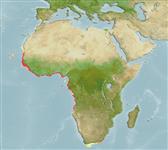Environment: milieu / climate zone / depth range / distribution range
Ecologia
marinhas; estuarina demersal. Tropical
Eastern Atlantic: Senegal to Angola (Ref. 57400). Also reported from Mauritania (Ref. 55783).
Comprimento de primeira maturação / Tamanho / Peso / Idade
Maturity: Lm 20.5 range ? - ? cm
Max length : 40.0 cm TL macho/indeterminado; (Ref. 2683); common length : 30.0 cm TL macho/indeterminado; (Ref. 2683)
Espinhos anais 3; Raios anais : 8 - 9. Diagnosis: body moderately stout, rounded in cross-section; head large, interorbital space almost flat; adipose eyelid well developed, extending unto pupil; upper lip thin, not ornamented (Ref. 57400). Upper lip with single comb-like series of setiform/cilliform, recurved (Ref. 57400, 81659), longish (Ref. 57400) unicuspid teeth, just visible to the naked eye as a fine fringe, and no inner rows (Ref. 81659). Lower lip without teeth, or with a single comb-like series of minute ciliiform teeth (not visible to naked eye) (Ref. 81659). 2nd row at base of lower lip in small fish (Ref. 57400). Hind end of upper jaw reaching a vertical line from posterior nostril; maxillary pad not visible below corner of mouth when closed; origin of first dorsal fin nearer to snout tip than to caudal-fin base; pectoral axillary process well developed (31.5-33% of pectoral-fin length)(Ref. 57400). 11-12 scale rows between origins of 1st dorsal and pelvic fins; anterior parts and bases of second dorsal and anal fins (sparsely) scaled; pelvic fins, anal and lower caudal fin lobe greyish to more or less whitish (never yellowish) (Ref. 57400, 81659).
Inhabits coastal waters (Ref. 2683, 7399, 57400), estuaries (Ref. 2683, 7399, 81659), inshore marine waters and lagoons (Ref. 81659). Also in high salinity waters (up to 73‰)(Ref. 57400). Feeds on phytoplankton and detritus (Ref. 28587). Oviparous, eggs are pelagic and non-adhesive (Ref. 205). Maximum FL reporded 260mm (Ref. 57400), maximum SL 260 mm, common length 200 mm SL (Ref. 81659).
Ciclo de vida ou comportamento de acasalamento
Maturidade | Reprodução | Desova | Ovos | Fecundidade | Larvas
Thomson, J.M., 1986. Mugilidae. p. 344-349. In J. Daget, J.-P. Gosse and D.F.E. Thys van den Audenaerde (eds.) Check-list of the freshwater fishes of Africa (CLOFFA). ISNB, Brussels, MRAC; Tervuren; and ORSTOM, Paris. Vol. 2. (Ref. 3573)
Status na Lista Vermelha da UICN (Ref. 130435)
Ameaça para os humanos
Harmless
Uso pelos humanos
Pescarias: espécies comerciais
Mais informação
ReferênciasAquaculturaPerfil para aquaculturaEstirpesGenéticaElectrophoresesHereditariedadeDoençasProcessamentoNutrientsConversão de massa
ColaboradoresFotosStamps, Coins Misc.SonsCiguateraVelocidadeTipo de nataçãoÁrea branquialOtólitosCérebrosVisão
Ferramentas
Relatórios especiais
Baixar XML
Fontes da internet
Estimates based on models
Preferred temperature (Ref.
123201): 23.4 - 27.9, mean 26.5 °C (based on 64 cells).
Índice de diversidade filogenética (Ref.
82804): PD
50 = 0.5000 [Uniqueness, from 0.5 = low to 2.0 = high].
Bayesian length-weight: a=0.01202 (0.00742 - 0.01949), b=2.98 (2.85 - 3.11), in cm total length, based on LWR estimates for this species & Genus-body shape (Ref.
93245).
Nível Trófico (Ref.
69278): 2.8 ±0.32 se; based on food items.
Generation time: 3.4 ( na - na) years. Estimated as median ln(3)/K based on 2
growth studies.
Resiliência (Ref.
120179): Elevada, tempo mínimo de duplicação da população menor que 15 meses (Preliminary K or Fecundity.).
Fishing Vulnerability (Ref.
59153): Low vulnerability (22 of 100).
Nutrients (Ref.
124155): Calcium = 405 [157, 1,261] mg/100g; Iron = 3.22 [0.59, 16.23] mg/100g; Protein = 19.4 [17.8, 20.9] %; Omega3 = 0.391 [0.171, 0.931] g/100g; Selenium = 129 [42, 423] μg/100g; VitaminA = 11.2 [3.4, 34.9] μg/100g; Zinc = 2.67 [1.26, 6.32] mg/100g (wet weight);
